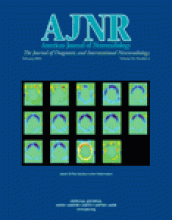OtherBrain
Pseudo-Subarachnoid Hemorrhage: A Potential Imaging Pitfall Associated with Diffuse Cerebral Edema
Curtis A. Given, Jonathan H. Burdette, Allen D. Elster and Daniel W. Williams
American Journal of Neuroradiology February 2003, 24 (2) 254-256;
Curtis A. Given II
Jonathan H. Burdette
Allen D. Elster

References
- ↵Eckel T, Breiter SN, Lee HM. Subarachnoid contrast enhancement after spinal angiography mimicking diffuse subarachnoid hemorrhage. AJR Am J Roentgenol 1998;170:503–505
- ↵Mendelsohn D, Moss ML, Chason DP, Muphree S, Casey S. Acute purulent leptomeningitis mimicking subarachnoid hemorrhage on CT. J Comput Assist Tomogr 1994;18:126–128
- ↵Osborn AG, Anderson RE, Wing DS. The false falx sign. Radiology 1980;134:421–425
- ↵Spiegel M, Fox AJ, Vinuela F, Pelz DM. Increased density of tentorium and falx: a false positive CT sign of subarachnoid hemorrhage. Can Assoc Radiol J 1986;37:243–247
- ↵Osborn AG. Diagnostic Neuroradiology. St Louis, Mo: Mosby-Year Book, Inc.;1994 :212
- ↵Al-Yamany M, Deck J, Bernstein M. Pseudo-subarachnoid hemorrhage: a rare neuroimaging pitfall. Can J Neurol Sci 1999;26:57–59
- ↵Avrahami E, Katz R, Rabin A, Friedman V. CT diagnosis of non-traumatic subarachnoid hemorrhage in patients with brain edema. Eur J Radiol 1998;28:222–225
- ↵Prockop LD, Fishman RA. Experimental pneumococcal meningitis. Arch Neurol19:449–463
- ↵Norman D, Price D, Boyd D, Fishman R, Newton TH. Quantitative aspects of computed tomography of the blood and cerebrospinal fluid. Radiology 1997;123:335–338
- ↵Klatzo I. Disturbances of the blood-brain barrier in cerebrovascular disorders. Acta Neuropathol (Berl) 1983 :suppl 8:81–88
- Weisberg L, Greenberg J, Stazio A. Computed tomographic findings in brain swelling. Comput Med Imaging Graph 1990;14:263–268
- ↵Rieth KG, Fujiwara K, Di Chiro G, et al. Serial measurements of CT attenuation and specific gravity in experimental cerebral edema. Radiology 1980;135:343–348
- ↵Marmarou A, Hochwald G, Nakamura T, Tanaka K, Weaver J, Dunbar J. Brain edema resolution by CSF pathways and brain vasculature in cats. Am J Physiol 1994;267(2 pt 2):H514–H520
- ↵Mei Liu H, Sturner WQ. Extravasation of plasma proteins in brain trauma. Forensic Sci Int 1988;38:285–295
- ↵Wolff HG, Forbes HS. The cerebral circulation: observations of the pial circulation during changes in intracranial pressure. Arch Neurol Psychiatr 1928;20:1035–1047
- Yada K, Nakagawa Y, Tsuru M. Circulatory disturbance of the venous system during experimental intracranial hypertension. J Neurosurg 1973;39:723–729
- Schmidek HH, Ludwig MA, Kapp JP. The cerebral venous system. Neurosurgery 1985;17:663–678
- ↵Osterholm JL. Reaction of the cerebral venous sinus system to acute intracranial hypertension. J Neurosurg 1970;32:654–659
- ↵Clasen RA, Huckman MS, Von Roenn KA, Pandolfi S, Laing I, Lobick J A correlative study of computed tomography and histology in human and experimental vasogenic cerebral edema. J Comput Assist Tomogr 1981;5:313–327
- ↵Cala LA, Thickbroom GW, Black JL, Collins DW, Mastaglia FL. Brain density and cerebrospinal fluid space size: CT of normal volunteers. AJNR Am J Neuroradiol 1981;2:41–47
- ↵
- ↵Ohkawa M, Masatada T, Toyama Y, et al. CT angiography with helical CT in assessment of acute stage of subarachnoid hemorrhage. Radiat Med 1998;16:91–97
- Mizoi K, Yoshimoto T, Fujiwara S, Sugawara T, Takahashi A, Koshu K. Prevention of vasospasm by clot removal and intrathecal bolus injection of tissue-type plasminogen activator: preliminary report. Neurosurgery 1991;28:807–812
- ↵Fujita S. Computed tomographic grading with Hounsfield number related to delayed vasospasm in cases of ruptured cerebral aneurysm. Neurosurgery 1985;17:609–612
In this issue
Advertisement
Curtis A. Given, Jonathan H. Burdette, Allen D. Elster, Daniel W. Williams
Pseudo-Subarachnoid Hemorrhage: A Potential Imaging Pitfall Associated with Diffuse Cerebral Edema
American Journal of Neuroradiology Feb 2003, 24 (2) 254-256;
0 Responses
Jump to section
Related Articles
- No related articles found.
Cited By...
This article has not yet been cited by articles in journals that are participating in Crossref Cited-by Linking.
More in this TOC Section
Similar Articles
Advertisement











